Ad Reinhardt said sculpture is what you bump into when backing up to see a painting (Thanks John Muse and Rob Matthews for the correction!). Bruce Nauman would probably beg to differ.
Nauman helped launch a new kind of sculpture that goes way beyond what that other 20th Century sculpture radical, Marcel Duchamp, did with his readymades. Nauman — who our favorite art critic Hennessy Youngman rails against — did everything! He performed, used video, audio, neon, even, and mechanical parts in his early works in the 1970s. And while he’s not the only one to radically shift sculpture off its pedestal he’s one of the artists who put sculpture on steroids.
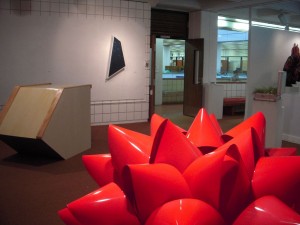
Nowadays Philadelphia is a hotbed for sculpture. Something about our DIY ethic and aesthetic fosters the growth of this land of makers. Witness, among other things, the new co-working sculpture space, Philadelphia Sculpture Gym.
215/610 at Delaware County Community College (up through Sept 21) is a juried sculpture show that includes everything except performance, although performance is hinted at in Jim Bigian’s puppet and a paper mache rooster headdress.
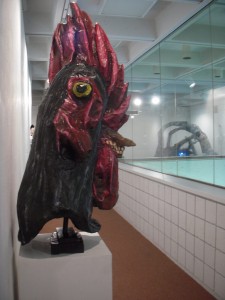
It’s a youthful show, filled with ideas and issues many young artists are concerned with, like the city, decay, pretty veneers that hide tough truths. And if you’re in the habit of viewing art at the Vox Building, you may well have seen a couple of these works before, like Piper Brett’s cherry red gift bow, which was in the juried Vox VI show in 2010. The piece is as big as a Smart car — and it’s built like one, out of steel.
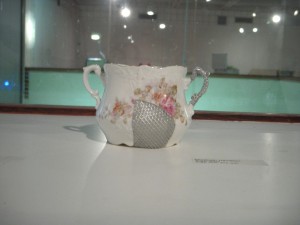
Elizabeth Hamilton’s broken and fixed teacup, creamer and sugar bowl, looking gorgeous with all the obvious repairs, were in last month’s show at Tiger Strikes Asteroid. It’s great to see Brett and Hamilton’s works again, and they travel well, looking proper in this oddly bifurcated academic gallery, with two spaces separated by large glass windows, a chasm in between and a narrow connecting corridor.
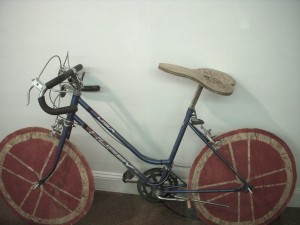
As the show’s guest curator Sid Sachs points out in his statement, contemporary sculpture is “raucous, scattered, sometimes formal and process oriented.” In addition, the works are all highly crafted, although not necessarily “finely” crafted. Pieces like Ashley Rodriguez Reed’s “Enchanted Hollow” and Corrina Mehiel’s bike works feel as if they were willed into being, their lumpiness and insistently non-design-y affect worn like badges. Crafting was clearly part of their art endeavor but not the end all.
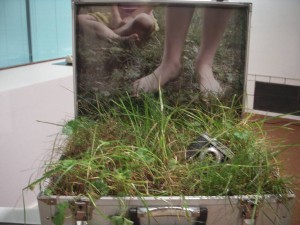
Of course nothing is new under the sun. But that never stopped anyone, nor should it. Brett’s bow, with its sense of play and menace, nods to Jeff Koons. Both artists celebrate the mundane world of birthday parties and presents, and all the emotions that go along with them. Brett’s piece, however, includes an added jolt of gender politics. It’s a hugely macho piece, bold and risk-taking, and made by a woman.
Robin Brewer’s You Can’t Take It With You, also nods — to Duchamp. The suitcase filled with grass, some found objects and a photo has a dreamy quality that is both seductive and a little morbid. Duchamp’s Boite en Valise — a little box with the world in it, as well as his Etant Donne, the peephole wonder at the PMA — are both references. Brewer even provides view finders for you to espy the details of her piece… They make great peep holes into the world created here.
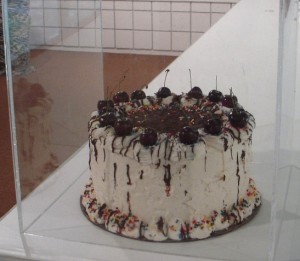
I told you in a previous post about Sara Gersbach’s voluptuous cake with an angry and funny audio. Less scary than Martha Rossler whipping out her butcher knives in her 1975 video Semiotics of the Kitchen, Gersbach’s domestic piece is more interiorized than Rossler’s full on manifesto about womens’ roles, and yet the dialog with the cake feels right for today’s tricky times for women who want to be both empowered and sexy, and yes, have their cake and eat it too.
Also good in this very nice show are Heather Ramsdale, Sarah Tortora, Nathaniel Mell and Jackie Brown.
When I visited the show I talked briefly with Jaime Treadwell, who teaches at DCCC and is involved with the gallery. He told me that when they began their annual juried show a few years ago and started programming edgy contemporary art, some of the faculty worried that the students wouldn’t get it. Treadwell says they not only get it, but they are loving it.





